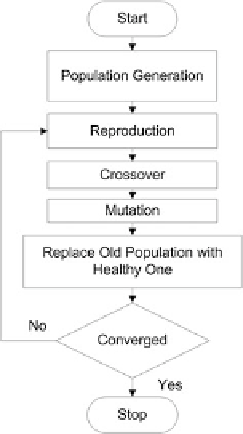Information Technology Reference
In-Depth Information
Fig. 7 Flowchart for the
optimal placement and sizing
of capacitor banks in
distribution system using GA
Particle Swarm Optimization (PSO)
PSO, developed by Eberhart and Kennedy (Valle et al.
2008
), is a soft computing
technique, inspired by the social behaviour of bird
fish schooling In
PSO, where swarm imitates the irregular movement of particles in the problem
space. It refers to the solutions as mass-less and volume-less particle, which are
subjected to velocities and accelerations towards a better mode of behaviour as the
possible solutions to the given problem. The population of particle move through
the hyperspace through a given velocity. At each iteration, the velocity of the
individual particles is stochastically adjusted according to the previous best position
for the particle itself, and neighbourhood
fl
flocking and
s best position. Both particles best and
neighbourhood best are derived based on the user de
'
fitness function (Valle
et al.
2008
). In addition, PSO utilizes the swarm intelligence concept which is the
property of the system, whereby collective behaviour of particles interacting locally
with their environment creates coherent global function patterns.
PSO is not largely affected by the size and non-linearity of the problem, and can
converge to the optimal solution in many problems, where most analytical methods
fail to converge. PSO has some advantages over other similar optimization tech-
niques such as (Valle et al.
2008
),
ned
1. It is easier to implement and has lesser parameters to adjust.
2. It has certain memory capability as; every particle remembers its own previous
best values as well as the neighbourhood best.
3. Since, all the particles use the information related to the most successful
particles in order to improve them. Thus, it is more ef
cient in maintaining the
diversity of the swarm.

Search WWH ::

Custom Search